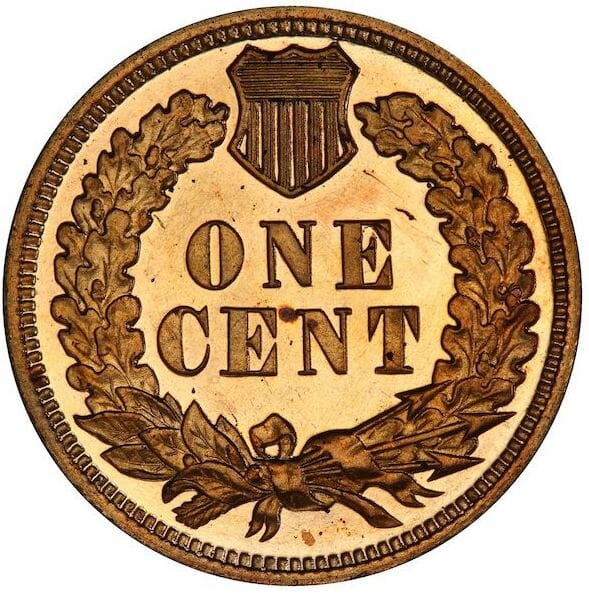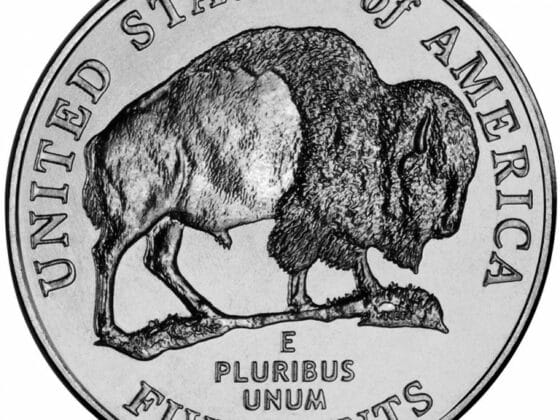Join us as we dive into numismatic history by looking at the 1904 Indian Head penny, which stands as a cherished artifact of a bygone era. While it might be called an Indian Head penny, the coin depicts Lady Liberty adorned with a feathered headdress rather than a Native American.
Thanks to its unique blend of history and design, it has captivated enthusiasts and historians alike. Join us as we examine its circulation, mintage, and error list.
Table of Contents
The 1904 Indian Head Penny Value
The value of a 1904 Indian Head Penny varies significantly, depending on its condition and whether the one-cent coin has any visible errors.
In average condition, the estimated value of a 1904 Indian Head Penny is around $3.38. However, it can be worth between $46 to $75 or more in uncirculated (MS+) Mint Condition. Proof coins, on the other hand, can be worth as much as $292 or more.
1904 Indian Head Penny Value Chart
| Mint Mark | Good | Fine | Extremely Fine | MS 60 Uncirculated/ MS 63 choice uncirculated | PR 63 |
| 1904 Indian Head Penny without Mint Mark | $2+ | $4+ | $15 | Up to $435 | |
| 1904 Proof Indian Head Penny | $11+ | $13+ | $18+ | Up to $10,000 | $250+ |
When it comes to the grading system for the 1904 Indian Head Penny’s value, the following factors apply:
- Good: The word “LIBERTY” which should be inscribed on Liberty’s headband cannot be seen.
- Fine: The word “LIBERTY” can be seen but is slightly worn.
- Extremely fine: The word “LIBERTY” is clear and sharp, as are other details on the coin, however, the end of the ribbon shows slight signs of wear.
- MS 60 uncirculated: No signs of wear are visible and while the coin has luster, there may be surface marks, abrasions, or stains.
- MS 63 choice uncirculated: There may be some contact marks or blemishes in the major focal areas and the coin’s luster may not be so prominent.
- PR 63 proof: The coin will have no major flaws, reflective surfaces, and a few blemishes away from the major focal points.
Related: Rare & Valuable Pennies – Find Out Which Pennies Are Worth Money
The 1904 Indian Head Penny – History, Composition & Design

Also known as the Indian Head cent, the Indian Head penny was produced by the United States Bureau of the Mint between 1859 and 1909. The coin’s designer was James Barton Longacre, the Chief Engraver at the Philadelphia Mint. But what about the 1904 coin in particular? Let’s examine its history, composition, and design in more detail.
There is much speculation about the origin of the design of James B. Longacre’s Indian Head penny. Rumor had it that it was based on a sketch of his eldest daughter. According to the story, she was trying on a headdress belonging to a group of Native Americans who were visiting while Longacre was designing the coin. Longacre strongly denied this and said the inspiration for the portrait on the coin was an ancient Greek statue.
The headdress depicted on the coin is like those worn by esteemed Native American warriors. However, it doesn’t match any specific style. It was purely drawn from Longacre’s imagination.
The 1904 Indian Head Penny was coined in Philadelphia, the location of the country’s primary mint at the time. This was the only location that made the pennies at the time. Therefore, there is no mint mark.
The number of Indian Head pennies minted during the year was 61,326,198. The estimated proof mintage is 1,817.
The coin’s value comes not from the scarcity of the coin but more from its unique character as a non-mint-marked piece.
Related: 1907 Indian Head Penny – A Closer Look at this Elusive Coin
Composition and Dimensions of the 1904 Indian Head Penny
The 1904 Indian Head Penn is a bronze-colored coin. Its composition is 95% copper, and the remaining 5% is made of a mix of zinc and tin, often called French Bronze. Occasionally, 5% might be just zinc or just tin.
The coin is 19.05mm in diameter and weighs 3.11g. It’s one of the Small Cents. In comparison, earlier cents were typically larger, often between 28mm and 29mm across.
The 1904 Indian Head Penny Design
The front or head side of the coin is known as the obverse, while the tail or back side is called the reverse. Let’s look at the distinct features of both sides of this coin.
Related: 1902 Indian Head Penny Value, History, Collectability, And Errors
The 1904 Indian Head Penny: Obverse

On the obverse or heads side of the penny, you’ll find a young Lady Liberty. Around her neck, there is a strand of pearls. On her head, she is wearing a headdress that is remarkably similar to those worn by Native American men.
In front of Liberty’s face are the words ‘UNITED STATES’. Behind her head sit the words ‘OF AMERICA’.
At the bottom of the coin is the date 1904. You’ll find an L in Liberty’s hair if you look closely. This is the mark that identified the designer, James B. Longacre.
The 1904 Indian Head Penny: Reverse

On the penny’s reverse, you’ll find the coin’s denomination: ONE CENT, sitting directly in the middle. Surrounding these words is a wreath of oak sprigs tied at the bottom of the coin with a ribbon. Also in the ribbon are three arrows.
At the top of the coin on the tail side, a shield sits directly between the tips of the oak wreath. The front and back rims both have denticles.
Related: The 1903 Indian Head Penny Value, History, Mint & Error List
1904 Indian Head Penny: Error List
As with so many other minted coins throughout history, there is a chance of minting mistakes taking place throughout the process.
It’s difficult to determine how many errors there might be, but the most common examples include doubling or tripling errors, which happen if the target moves between strikes inside a dated coin press.
Other possible minting mistakes include overlapping engravings, denomination errors, damaged strikes, die caps from jammed feeders and hoppers, and contaminants getting mashed onto coins.
While some of these errors can be spotted with the naked eye, others require a magnifying glass, jeweler’s loupe, or coin microscope to spot them.
So, are there any mint errors that are worth looking for? Here are a couple of examples of errors that may increase the value of the 1904 Indian Head Penny.
RPD FS-301 Error

This is one of the rarer error types on the 1904 Indian Head Penny. The error would have occurred when a mint employee double- or triple-digit stamped a die by mistake. The result is a re-punched date (RPD).
In the FS-301 variant of this error, the number nine in the date seems doubled, but you must look very closely.
Collectors widely seek this error type. It’s not as precious as other faults, but RPD FS-301 1904 Indian Head Penny coins will have a higher market value.
Struck 10% Off-Center

There are occasions when a count is struck off-center and there are examples of this type of error in minting the 1904 Indian Head Penny. When this happens, part or all of the design is missing.
Coins displaying this error are incredibly attractive for collectors because they are unique and scarce. The coin’s general condition and the degree of off-center strike determine how much these coins are worth. Typically, they are sold for a minimum of $50 above their original value.
The 1904 Indian Head Penny: FAQs
How much is a 1904 Indian Head Penny worth?
The face value of this coin is merely one cent. However, in terms of its numismatic value, it very much depends on the features of the coin. An average penny’s value will be little more than a few dollars.
However, rarer examples of the 1904 Indian Head Penny have sold at auction for tens of thousands of dollars.
The highest value was $33,600 for a Mint State red-colored 1904 Indian Head Penny that sold at Heritage Auctions in 2019.
What makes a 1904 Indian Head Penny valuable?
The value of a 1904 Indian Head Penny depends mainly on its condition, ranging from a couple of dollars for a coin rated as a good condition to MS 63 grade with a value of around $70.
Where is the mint mark on a 1904 penny?
There is no mint mark on a 1904 penny because they were only minted in one location, Philadelphia.
Is a 1905 Indian Head Penny worth anything?
Yes, a 1905 Indian Head Penny can be worth between $2 and $35, depending on its condition.
Conclusion
The 1904 Indian Head Penny is another fine example of the long-running and popular one-cent coin type issued in large numbers in the USA. The value of these coins can vary, depending on their condition and whether they exhibit any unusual mint errors. Typically, they can be worth a couple of dollars, up to $10,000 or more.
There is a mystical charm that surrounds coinage, and while some are incredibly common, there are others that are extremely rare. If you are interested in pursuing numismatics, always be aware of coin counterfeits and only use reputable TPGCs (third-party grading companies), such as PGCS and NGC. Finally, remember how important the quality of preservation is.
Collectible coins should have minimum contact with air and other coins. In addition, never attempt to clean an old coin yourself, as this could cause serious damage.











